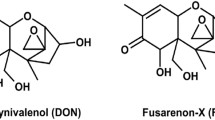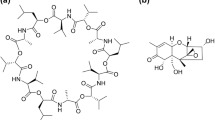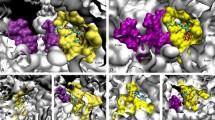Abstract
The global incidence of Fusarium head blight and attendant cereal grains multi-contamination by the trichothecene mycotoxins deoxynivalenol (DON) and nivalenol (NIV) are increasing as a possible result of climate change and inadequate agricultural practices. At the molecular level, these mycotoxins bind to the ribosome, activate the mitogen-activated protein kinase and induce a local and systemic inflammation. DON is of public health concern owing to the narrow margin between exposure and tolerable daily intake. The intestinal inflammatory response to DON, NIV and their mixture was analyzed to determine thresholds for their intestinal pro-inflammatory effects and characterize the type and magnitude of their interaction. Fully differentiated three-dimensional porcine jejunal explants were exposed to increasing doses of DON and NIV alone or in combination; the expression levels of IL-1α, IL-1β, IL-8, IL-17A and IL-22 were measured by RT-PCR. Doses as low as 0.16 µM DON or 0.73 µM NIV significantly increase the intestinal expression levels of the tested inflammation-related genes. These doses are lower than those previously reported for other intestinal toxicity endpoints. The combined pro-inflammatory activity of DON and NIV was synergistic for all the tested genes with combination index value range of 0.23–0.8. Our results indicate that (1) inflammation is a very sensitive endpoint for the intestinal toxicity of the trichothecenes and (2) co-exposure to DON and NIV has a greater inflammatory effect than induced by mycotoxins alone. This synergy should be taken into account considering the frequent co-occurrence of DON and NIV in the diet.




Similar content being viewed by others
References
Abia WA, Warth B, Sulyok M et al (2013) Bio-monitoring of mycotoxin exposure in Cameroon using a urinary multi-biomarker approach. Food Chem Toxicol 62:927–934. doi:10.1016/j.fct.2013.10.003
Alassane-Kpembi I, Kolf-Clauw M, Gauthier T et al (2013) New insights into mycotoxin mixtures: the toxicity of low doses of type B trichothecenes on intestinal epithelial cells is synergistic. Toxicol Appl Pharmacol 272:191–198. doi:10.1016/j.taap.2013.05.023
Alassane-Kpembi I, Puel O, Oswald IP (2015) Toxicological interactions between the mycotoxins deoxynivalenol, nivalenol and their acetylated derivatives in intestinal epithelial cells. Arch Toxicol 89:1337–1346. doi:10.1007/s00204-014-1309-4
Alassane-Kpembi I, Schatzmayr G, Taranu I, Marin D, Puel O, Oswald IP (2017) Mycotoxins co-contamination: methodological aspects and biological relevance of combined toxicity studies. Crit Rev Food Sci Nutr. doi:10.1080/10408398.2016.1140632
Amuzie CJ, Shinozuka J, Pestka JJ (2009) Induction of suppressors of cytokine signaling by the trichothecene deoxynivalenol in the mouse. Toxicol Sci 111:277–287. doi:10.1093/toxsci/kfp150
Bracarense AP, Lucioli J, Grenier B et al (2012) Chronic ingestion of deoxynivalenol and fumonisin, alone or in interaction, induces morphological and immunological changes in the intestine of piglets. Br J Nutr 107:1776–1786. doi:10.1017/S0007114511004946
Calabrese EJ, Baldwin LA (2003) Hormesis: the dose-response revolution. Annu Rev Pharmacol Toxicol 43:175–197. doi:10.1146/annurev.pharmtox.43.100901.140223
Cano PM, Seeboth J, Meurens F et al (2013) Deoxynivalenol as a new factor in the persistence of intestinal inflammatory diseases: an emerging hypothesis through possible modulation of Th17-mediated response. PLoS ONE 8:e53647. doi:10.1371/journal.pone.0053647
CAST (2003) Mycotoxins: risks in plant, animal and human systems. In: council for agricultural science and technology (ed) Task force report, vol. 139. Ames, p 199
Chou TC (2006) Theoretical basis, experimental design, and computerized simulation of synergism and antagonism in drug combination studies. Pharmacol Rev 58:621–681. doi:10.1124/pr.58.3.10
Chou TC (2011) The mass-action law based algorithms for quantitative econo-green bio-research. Integr Biol (Camb) 3:548–559. doi:10.1039/c0ib00130a
Chou TC, Martin N (2005) CompuSyn for drug combinations: PC software and user’s guide: a computer program for quantitation of synergism and antagonism in drug combinations, and the determination of IC50 and ED50 and LD50 values. ComboSyn Inc, Paramus
Chou TC, Talalay P (1984) Quantitative analysis of dose-effect relationships: the combined effects of multiple drugs or enzyme inhibitors. Adv Enzyme Regul 22:27–55
Crump KS (1995) Calculation of benchmark doses from continuous data. Risk Anal 15(1):79–89
Del Ponte EM, Garda-Buffon J, Badiale-Furlong E (2012) Deoxynivalenol and nivalenol in commercial wheat grain related to Fusarium head blight epidemics in southern Brazil. Food Chem 132:1087–1091. doi:10.1016/j.foodchem.2011.10.108
EFSA (2013a) Deoxynivalenol in food and feed: occurrence and exposure. EFSA J 11:56. doi:10.2903/j.efsa.2013.3379
EFSA (2013b) Scientific Opinion on risks for animal and public health related to the presence of nivalenol in food and feed. EFSA J 11:119. doi:10.2903/j.efsa.2013.3262
Filipsson AF, Sand S, Nilsson J, Victorin K (2003) The benchmark dose method—review of available models, and recommendations for application in health risk assessment. Crit Rev Toxicol 33:505–542. doi:10.1080/10408440390242360
Fredlund E, Gidlund A, Sulyok M et al (2013) Deoxynivalenol and other selected Fusarium toxins in Swedish oats—occurrence and correlation to specific Fusarium species. Int J Food Microbiol 167:276–283. doi:10.1016/j.ijfoodmicro.2013.06.026
Grenier B, Loureiro-Bracarense AP, Lucioli J et al (2011) Individual and combined effects of subclinical doses of deoxynivalenol and fumonisins in piglets. Mol Nutr Food Res 55:761–771. doi:10.1002/mnfr.201000402
Halloy DJ, Gustin PG, Bouhet S, Oswald IP (2005) Oral exposure to culture material extract containing fumonisins predisposes swine to the development of pneumonitis caused by Pasteurella multocida. Toxicology 213(1–2):34–44
Hedman R, Pettersson H, Lindberg JE (1997) Absorption and metabolism of nivalenol in pigs. Arch Tierernahr 50:13–24
Iordanov MS, Pribnow D, Magun JL et al (1997) Ribotoxic stress response: activation of the stress-activated protein kinase JNK1 by inhibitors of the peptidyl transferase reaction and by sequence-specific RNA damage to the alpha-sarcin/ricin loop in the 28S rRNA. Mol Cell Biol 17:3373–3381
JECFA F (2011) Safety evaluation of certain contaminants in food/prepared by the Seventy-second meeting of the Joint FAO/WHO Expert Committee on Food Additives (JECFA). In: Food and Agriculture Organization of the United Nations R (ed) FAO JECFA monographs, vol 8. Food and Agriculture Organization of the United Nations (FAO), Rome
Kinser S, Jia Q, Li M et al (2004) Gene expression profiling in spleens of deoxynivalenol-exposed mice: immediate early genes as primary targets. J Toxicol Environ Health A 67:1423–1441. doi:10.1080/15287390490483827
Lucioli J, Pinton P, Callu P et al (2013) The food contaminant deoxynivalenol activates the mitogen activated protein kinases in the intestine: interest of ex vivo models as an alternative to in vivo experiments. Toxicon 66:31–36. doi:10.1016/j.toxicon.2013.01.024
Madhyastha MS, Marquardt RR, Abramson D (1994) Structure-activity relationships and interactions among trichothecene mycotoxins as assessed by yeast bioassay. Toxicon 32(9):1147–1152. doi:10.1016/0041-0101(94)90398-0
Maresca M (2013) From the gut to the brain: journey and pathophysiological effects of the food-associated trichothecene mycotoxin deoxynivalenol. Toxins (Basel) 5:784–820. doi:10.3390/toxins5040784
Maresca M, Yahi N, Younes-Sakr L, Boyron M, Caporiccio B, Fantini J (2008) Both direct and indirect effects account for the pro-inflammatory activity of enteropathogenic mycotoxins on the human intestinal epithelium: stimulation of interleukin-8 secretion, potentiation of interleukin-1beta effect and increase in the transepithelial passage of commensal bacteria. Toxicol Appl Pharmacol 228:84–92. doi:10.1016/j.taap.2007.11.013
Payros D, Alassane-Kpembi I, Pierron A, Loiseau N, Pinton P, Oswald IP (2016) Toxicology of deoxynivalenol and its acetylated and modified forms. Arch Toxicol 90:2931–2957. doi:10.1007/s00204-016-1826-4
Pestka JJ (2010a) Deoxynivalenol-induced proinflammatory gene expression: mechanisms and pathological sequelae. Toxins (Basel) 2:1300–1317. doi:10.3390/toxins2061300
Pestka JJ (2010b) Deoxynivalenol: mechanisms of action, human exposure, and toxicological relevance. Arch Toxicol 84:663–679. doi:10.1007/s00204-010-0579-8
Pierron A, Mimoun S, Murate LS et al (2016a) Microbial biotransformation of DON: molecular basis for reduced toxicity. Sci Rep 6:29105. doi:10.1038/srep29105
Pierron A, Mimoun S, Murate LS et al (2016b) Intestinal toxicity of the masked mycotoxin deoxynivalenol-3-beta-D-glucoside. Arch Toxicol 90:2037–2046. doi:10.1007/s00204-015-1592-8
Pinton P, Oswald IP (2014) Effect of deoxynivalenol and other Type B trichothecenes on the intestine: a review. Toxins (Basel) 6:1615–1643. doi:10.3390/toxins6051615
Pinton P, Braicu C, Nougayrede JP, Laffitte J, Taranu I, Oswald IP (2010) Deoxynivalenol impairs porcine intestinal barrier function and decreases the protein expression of claudin-4 through a mitogen-activated protein kinase-dependent mechanism. J Nutr 140:1956–1962. doi:10.3945/jn.110.123919
Poapolathep A, Sugita-Konishi Y, Doi K, Kumagai S (2003) The fates of trichothecene mycotoxins, nivalenol and fusarenon-X, in mice. Toxicon 41:1047–1054. doi:10.1016/S0041-0101(03)00089-8
Randall KJ, Turton J, Foster JR (2011) Explant culture of gastrointestinal tissue: a review of methods and applications. Cell Biol Toxicol 27(4):267–284. doi:10.1007/s10565-011-9187-5
Scaldaferri F, Fiocchi C (2007) Inflammatory bowel disease: progress and current concepts of etiopathogenesis. J Dig Dis 8:171–178. doi:10.1111/j.1751-2980.2007.00310.x
Schothorst RC, van Egmond HP (2004) Report from SCOOP task 3.2.10 “collection of occurrence data of Fusarium toxins in food and assessment of dietary intake by the population of EU member states”. Subtask: trichothecenes. Toxicol Lett 153:133–143. doi:10.1016/j.toxlet.2004.04.045
Sirot V, Fremy JM, Leblanc JC (2013) Dietary exposure to mycotoxins and health risk assessment in the second French total diet study. Food Chem Toxicol 52:1–11. doi:10.1016/j.fct.2012.10.036
Tajima O, Schoen ED, Feron VJ, Groten JP (2002) Statistically designed experiments in a tiered approach to screen mixtures of Fusarium mycotoxins for possible interactions. Food Chem Toxicol 40:685–695. doi:10.1016/S0278-6915(01)00124-7
Tanaka H, Sugita-Konishi Y, Takino M, Tanaka T, Toriba A, Hayakawa K (2010) A survey of the occurrence of Fusarium mycotoxins in biscuits in Japan by using LC/MS. J Health Sci 56:188–194
Tardivel C, Airault C, Djelloul M et al (2015) The food born mycotoxin deoxynivalenol induces low-grade inflammation in mice in the absence of observed-adverse effects. Toxicol Lett 232:601–611. doi:10.1016/j.toxlet.2014.12.017
Tep J, Videmann B, Mazallon M, Balleydier S, Cavret S, Lecoeur S (2007) Transepithelial transport of fusariotoxin nivalenol: mediation of secretion by ABC transporters. Toxicol Lett 170:248–258. doi:10.1016/j.toxlet.2007.03.012
Thomas RS, Clewell HJ 3rd, Allen BC et al (2011) Application of transcriptional benchmark dose values in quantitative cancer and noncancer risk assessment. Toxicol Sci 120:194–205. doi:10.1093/toxsci/kfq355
Turner PC, Rothwell JA, White KLM, Gong YY, Cade JE, Wild CP (2007) Urinary deoxynivalenol is correlated with cereal intake in individuals from the United Kingdom. Environ Health Perspect 116(1):21–25
Videmann B, Tep J, Cavret S, Lecoeur S (2007) Epithelial transport of deoxynivalenol: involvement of human P-glycoprotein (ABCB1) and multidrug resistance-associated protein 2 (ABCC2). Food Chem Toxicol 45:1938–1947. doi:10.1016/j.fct.2007.04.011
Zhou HR, Islam Z, Pestka JJ (2003) Rapid, sequential activation of mitogen-activated protein kinases and transcription factors precedes proinflammatory cytokine mRNA expression in spleens of mice exposed to the trichothecene vomitoxin. Toxicol Sci 72:130–142
Acknowledgements
The authors are grateful to Yannick LIPPI from the Toxalim Research Centre TRiX Facility for excellent technical assistance in data handling. This study was supported by Conseil Général de Midi-Pyrénées (Project No. 14051022 Tool4GutHealth) and Agence Nationale de la Recherche (Project ANR-10 CESA DON&Co and Project ANR-15-CE21-0001-02 CaDON). I. A. K. was supported by a doctoral fellowship from the Government of Republic of Benin.
Author information
Authors and Affiliations
Corresponding author
Ethics declarations
Conflict of interest
Authors declare no conflict of interest.
Electronic supplementary material
Below is the link to the electronic supplementary material.
Rights and permissions
About this article
Cite this article
Alassane-Kpembi, I., Puel, O., Pinton, P. et al. Co-exposure to low doses of the food contaminants deoxynivalenol and nivalenol has a synergistic inflammatory effect on intestinal explants. Arch Toxicol 91, 2677–2687 (2017). https://doi.org/10.1007/s00204-016-1902-9
Received:
Accepted:
Published:
Issue Date:
DOI: https://doi.org/10.1007/s00204-016-1902-9




